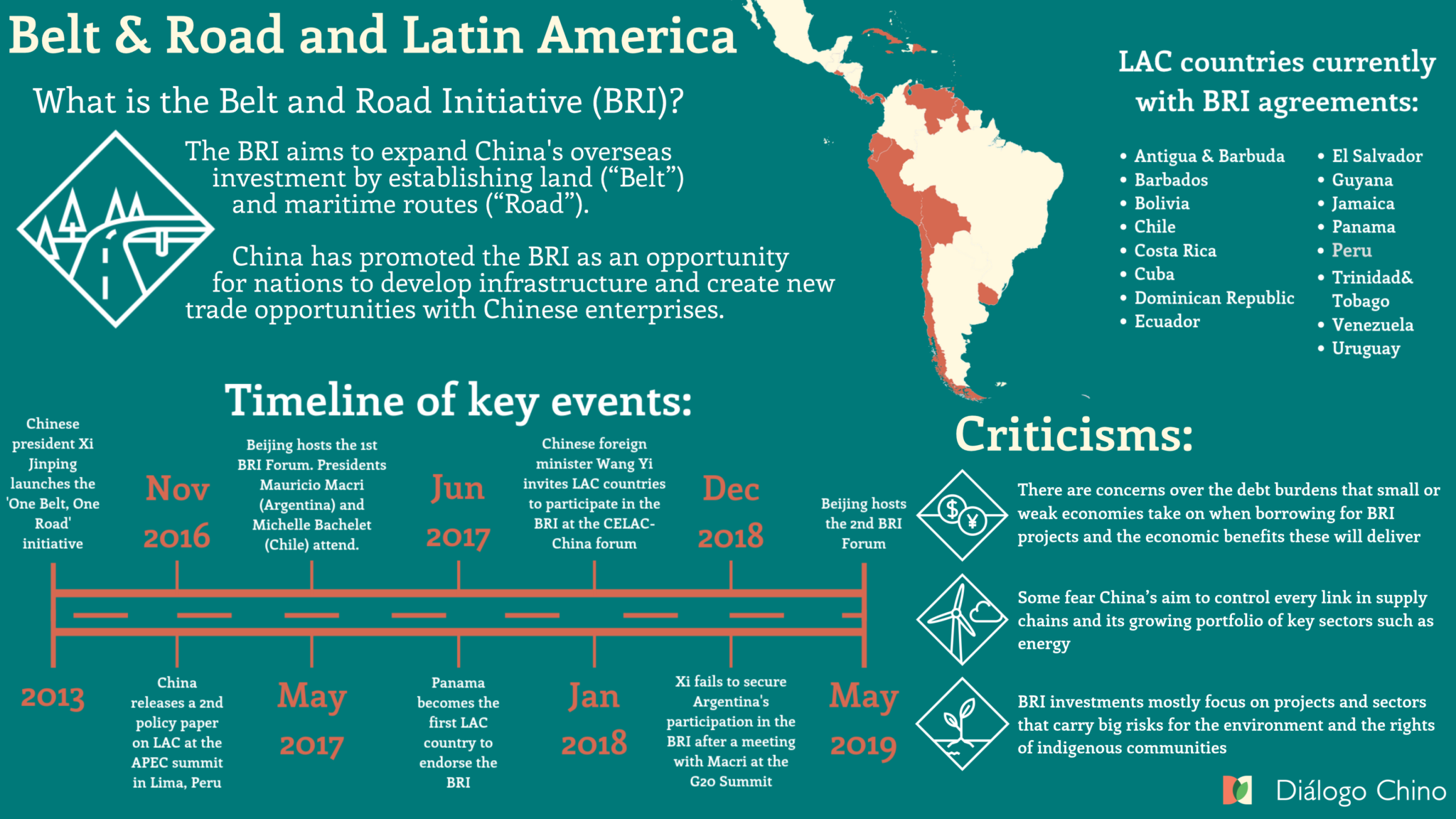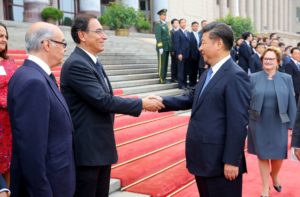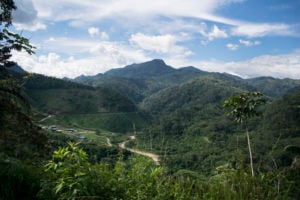In April, Peru announced that it will join China’s Belt and Road Initiative (BRI), becoming the 19th country in Latin America and the Caribbean to join Chinese President Xi Jinping’s flagship foreign policy.
China’s connectivity plan aims to resurrect the ancient Silk Road and maritime trade routes, as well as developing new links, and to enhance economic and political cooperation between participating countries and regions. Initially designed to incorporate Europe and Asia at its launch in 2013, the 20-fold increase in the volume of trade between China and Latin America in just a decade has meant the region is now considered “a natural extension” of the project.
Since Panama joined in 2017, Latin America has been linked to this multibillion-dollar network of infrastructure projects that also facilitates access to new sources of financing. However, until now, the four largest economies in the region – Brazil, Mexico, Argentina and Colombia – have been reluctant to join, amid vocal US criticisms about indebtedness.
The arrival of Peru – Latin America’s sixth largest economy and one that has had a Free Trade Agreement with China for a decade – could boost the BRI in Andean region.
Peru: new addition resurrects the railway
Date signed: April 2019
What they said: “The act of signing this memorandum of understanding is the beginning of a cooperation model that China has offered to the world that I think is interesting and that allows expanding the bonds of cooperation” (Vice President Mercedes Aráoz)
Flagship projects: Although two years ago Peru ruled it out because of costs, President Martín Vizcarra confirmed during his April trip to China that he is interested in reviving the interoceanic railroad with Brazil and Bolivia, which could cost up to U$60 billion. The turnaround is due in part to new studies that estimate the Peruvian part would cost US$7.500 billion, one fifth of the original quote. Vizcarra said: “we are interested, Bolivia is even more interested, (…) but let’s see, because between the two of them a third partner is missing in order to carry out the project.”
Other projects underway, which will be rebranded under the BRI, include the construction of a mega port in Chancay and another in Ilo, as well as being the second largest foreign investor in the mining sector, owning the Las Bambas copper mine in Toromocho and the Marcona iron ore mine.
Concerns: “The art of a lender is to keep a guarantee that has more value than the amount lent. The fear of borrowing countries is to fall into a hypothetical Chinese sphere – with a Chinese bank, Chinese credit, Chinese company, Chinese labour, and Chinese materials and resources – that minimises the transfer of technology and the creation of local employment” – Patricia Castro Obando, a journalist specialising in China.
Ecuador: the most projects
President Lenin Moreno’s visit to Beijing in December served to set in stone Ecuador’s accession to BRI and a flurry of new investments. Yet, Ecuador is already the third largest recipient of Chinese finance in the region, just behind Venezuela and Brazil.
Date signed: December 2018
What they said: “For us, China is a benchmark for innovation and development. Currently 145 companies from this country work and invest in Ecuador, generating jobs, growth, employment and the exchange of technology and knowledge” – President Lenin Moreno.
Flagship projects: Among the new projects that were announced are the reconstruction of the Manta airport, which was hit by the 2016 earthquake, the highway between Quinindé and Las Golondrinas (between the provinces of Esmeraldas and Imbabura) and two bridges in Canuto and Pimpiguasí (Manabí province). In practice, however, there are already a dozen projects that will now fall under the BRI umbrella, including seven hydroelectric plants (the largest of them, Coca Codo Sinclair has had many problems) and the copper mines of Panantza-San Carlos and Mirador (which have seen strong socio-environmental conflicts).
Concerns: “This close relationship has caused Ecuador to develop a dependent relationship with China and to be contemplative in the face of the socio-environmental impacts and intense conflicts caused by their companies” – Center for Economic and Social Rights ( CEDS)
[chinadialogue_fullwidth]
 [/chinadialogue_fullwidth]
[/chinadialogue_fullwidth]
Bolivia: looking for roads
Date signed: June 2018
What they said: “The Belt and Road Initiative and Latin America and the Caribbean’s cooperation with China will play a decisive role in achieving the Sustainable Development Goals” – Diego Pary Rodríguez, Bolivia’s foreign minister
Flagship projects: Most of the projects underway with Chinese support are roads, including El Sillar (a stretch on the highway from Santa Cruz to Cochabamba), Rurrenabaque to Riberalta in the Amazon, and El Espino to Boyuibe in the Chaco, although there are also others such as the Mutún steel plant and the joint exploitation of lithium in the southern salt flats of the country. Other projects have been less fortunate. The controversial Rositas hydroelectric dam has stalled and the extension of the Santa Cruz airport has been cancelled.
Concerns: “A characteristic of the relations between China and Bolivia is the scarce information, the contradictions in the declarations of authorities and the non-disclosure of agreements and financing agreements” – Silvia Molina and Viviana Herrera, Centre for the Study of Labour Agrarian Development (CEDLA).
Venezuela: Belt and Road navigates political crisis
China, has loaned Venezuela more than US$67 billion, according to Inter-American Dialogue. Much is repaid with oil revenues. As such, China is seen as a key figure in the political crisis.
Though China was a pillar of support to the Hugo Chavez government (1998-2013), it has seemingly chosen to keep channels open also with the opposition as the country slipped deeper into political and economic crisis. This position is consistent with its ‘pragmatic’ foreign policy. Self-proclaimed president Juan Carlos Guaidó surprised a public meeting a few weeks ago when he said Chinese diplomats had assured him that “a solution is approaching through the Contact Group” that tries to mediate between the two.
Date signed: December 2017
What they said: “We will receive billions of dollars in investment to make our joint ventures in oil fields a reality” – President Nicolás Maduro
Flagship projects: In the last decade China and Venezuela have agreed to push forward hundreds of projects, though progress on many is unclear. These include the La Cabrera thermoelectric plant, which currently operates at a fraction of its capacity, and the El Vigía power plant, also partially operational. Others have been a failure, such as the abandoned rice processing plant in Delta Amacuro, which was set to be the largest in Latin America.
Concerns: “Alas, Pakistan, Sri Lanka, South Africa, Ecuador, and Venezuela have learned the hard way, Chinese development finance often delivers a corruption-filled sugar high to the economy, followed by a nasty financial (and sometimes political) hangover.” – Ricardo Hausmann, former minister and economic adviser to Guaidó
Colombia: the only one missing
With Peru endorsing the BRI, Colombia remains the only Andean country on the sidelines. This is understandable when considering that, of the five countries, it has prioritised China the least in its political agenda. Under new president Iván Duque, Colombia focuses mainly on the political crisis in Venezuela and the US’ strategy in the region.
China, however, has made strong overtures: “Colombia is an important country in Latin America that has good bilateral relations with China; a further expansion of cooperation for mutual benefit is in line with the interests of both parties and has great potential,” Chinese ambassador Li Nianping wrote a month ago in an opinion column in national El Tiempo, in which he invited the country to join.
Date signed: Not signed
What they said: “The national government recognises the international importance of this initiative and is currently evaluating the proposal’s content presented by China, in its different dimensions, in order to define its possible participation” (Foreign Minister Carlos Holmes Trujillo)
Flagship projects: At the moment there are few Chinese projects in Colombia, apart from the Sea Motorway 2 that connects the Gulf of Urabá in the Caribbean. There are also new fleets of electric buses in Cali and Medellín and several oil fields that the state-owned Sinochem seeks to exploit. These have been blighted by social conflicts.
Concerns: “Let’s not forget that this finance came tied to demanding conditions on accepting goods and services offered by China…Colombia has space to deepen its commercial relations with China, but to do this it will first have to enable the Pacific coast for foreign trade” – Sergio Clavijo, president of the National Association of Financial Institutions (ANIF)









